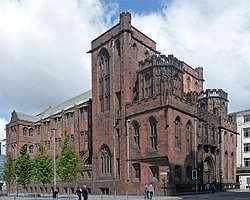| John Rylands Research Institute and Library | |
|---|---|
 | |
| Alternative names | Rylands |
| General information | |
| Type | Library |
| Architectural style | Victorian Neo-Gothic |
| Location | Deansgate, Manchester, England |
| Coordinates | 53°28′49″N 2°14′55″W / 53.480321°N 2.2487°W |
| Construction started | 1890 |
| Completed | 1899[1] |
| Opened | 1 January 1900 |
| Inaugurated | 6 October 1899 |
| Renovated | 1920, 1962, 2003–07 |
| Cost | £200,000[2][3] |
| Owner | University of Manchester |
| Design and construction | |
| Architect(s) | Basil Champneys[1] |
| Main contractor | R. and W. Morrison, Liverpool |
| Designations | |
Listed Building – Grade I | |
| Official name | John Rylands Library and attached railings, gates and lamp standards |
| Designated | 25 January 1952 |
| Reference no. | 1217800 |
| Website | |
| Official website | |
The John Rylands Research Institute and Library is a late-Victorian neo-Gothic building on Deansgate in Manchester, England. It is part of the University of Manchester.[4] The library, which opened to the public in 1900, was founded by Enriqueta Augustina Rylands in memory of her husband, John Rylands.[5] It became part of the university in 1972, and now houses the majority of the Special Collections of The University of Manchester Library, the third largest academic library in the United Kingdom.
Special collections built up by both libraries were progressively concentrated in the Deansgate building. The special collections, believed to be among the largest in the United Kingdom,[6] include medieval illuminated manuscripts and examples of early European printing, including a Gutenberg Bible, the second largest collection of printing by William Caxton,[7] and the most extensive collection of the editions of the Aldine Press of Venice.[8] The Rylands Library Papyrus P52 has a claim to be the earliest extant New Testament text. The library holds personal papers and letters of notable figures, among them the novelist Elizabeth Gaskell and the scientist John Dalton.
The architectural style is primarily neo-Gothic with elements of the Arts and Crafts movement in the ornate and imposing gatehouse, facing Deansgate, which dominates the surrounding streetscape. The library, granted Grade I listed status in 1994, is maintained by the University of Manchester and open for library readers and visitors.
The library is one of the museum, library and archive collections of national and international importance under the Designation Scheme for England.[9] As of 2020[update], 152 collections are officially designated.[10]
- ^ a b "Plan of John Rylands Library, Manchester". Archived from the original on 6 January 2013. Retrieved 29 April 2007.
{{cite web}}: CS1 maint: unfit URL (link) - ^ "John Rylands Library", Engineering Timelines, retrieved 25 February 2012
- ^ According to Clare Hartwell the cost was £230,000:-Hartwell, Clare (2001), Manchester, Pevsner Architectural Guides, London: Penguin Books, ISBN 978-0-14-071131-8
- ^ "John Rylands Research Institute and Library (The University of Manchester Library)". library.manchester.ac.uk. Retrieved 12 March 2022.
- ^ "JRUL Special Collections: Visitor Information". Archived from the original on 18 July 2012. Retrieved 29 April 2007.
- ^ "What are Special Collections?". University of Manchester. Archived from the original on 2 February 2012. Retrieved 6 January 2012.
- ^ "Incunabula Collection". The University of Manchester. Archived from the original on 1 June 2012. Retrieved 25 February 2012.
- ^ "Aldine Press". The University of Manchester. Archived from the original on 17 May 2012. Retrieved 25 February 2012.
- ^ "Arts Council - Designation Scheme". Archived from the original on 18 July 2012. Retrieved 10 August 2012.
- ^ "Designated Collections | Arts Council England". artscouncil.org.uk. Retrieved 25 August 2020.